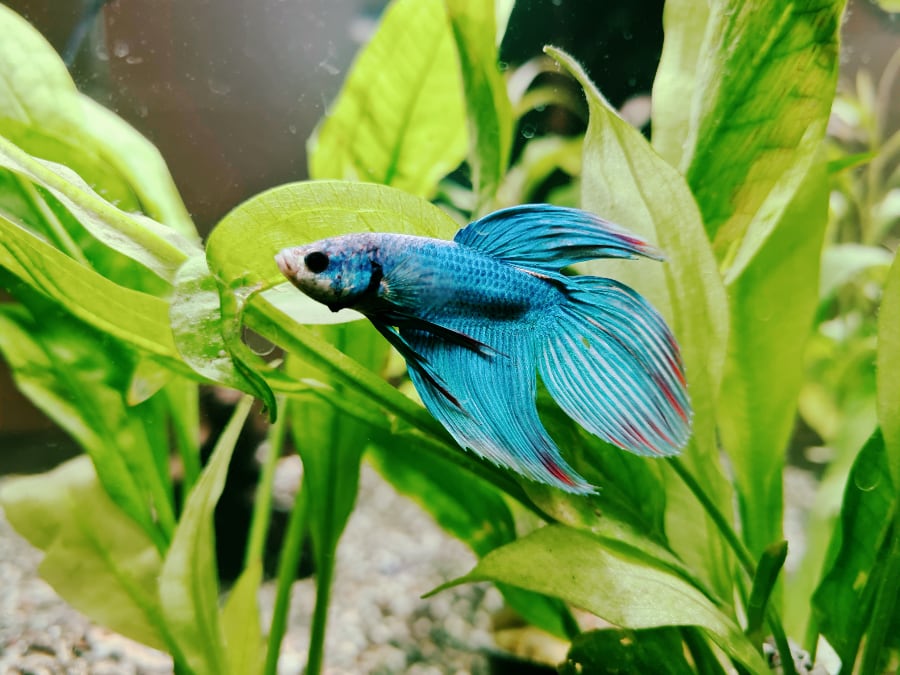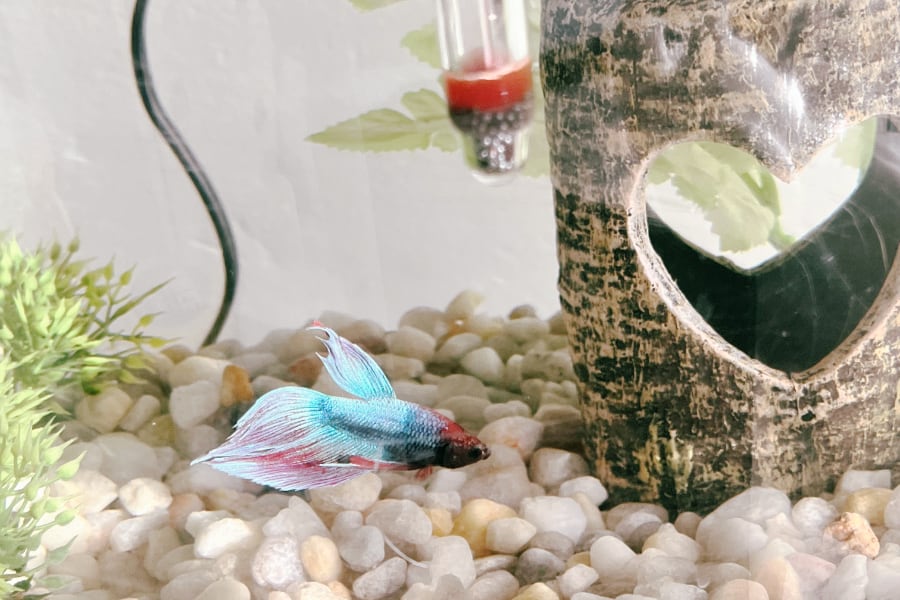Betta splendens, more commonly known as the veiltail betta fish, is a colorful tropical fish that is quite popular. The fish got its moniker “Veiltail” because its tail looks like a transparent piece of shiny fabric.
These fish are native only to a small region of Southeast Asia, but they have become common household pets in many countries. Huge swaths of Cambodia, Thailand, and Indonesia are home to this species.
In Thailand, it was formerly known as Siam. The name “Siamese fighting fish” comes from the common occurrence of violent battles between pairs of these fish.
However, do you want to understand more about this fish? Relax! This article provides all the information you need.
The Apparent Differences
Veiltail Bettas are Bettas with a veil-like tail that sags from behind the fin. They come in a wide range of vibrant colors. The most common colors are royal blue and turquoise, but they are also available in bright yellow, emerald green, deep purple, and fire engine red.
Males are more visually impressive than females, as is the case with the majority of Betta species. Furthermore, males have slightly longer fins than females. Females are pear-shaped, whereas males are triangular.
This species comes in a variety of colors, but no matter which one you choose, its body will have a lot of shimmers and a nearly iridescent sheen.
Another feature that distinguishes female bettas from males is the ovipositor. The female reproductive organ is the oviduct.
Veiltail Betta Behavior and Temperament
This species of fish has a reputation for being peaceful. They will wiggle their tails when their owner approaches and may even swim to the front of the tank to get a better look.
A close inspection of the Betta’s fins can reveal whether the fish is healthy in its tank. The fins will be floppy, slack, and flapping in the water aimlessly. Slow, relaxed swimming motions are signs of a contented, happy, and well-adjusted veiltail betta fish.
In contrast, if he is swimming around very quickly and appears to be moving frenetically; rushing from one side of the tank to the other and back again; bumping into things along the way; he is most likely stressed and anxious. It’s also possible that the fish is preparing to attack its aquarium mates at this time.
Are Veiltail Bettas Aggressive?
Aggression is a characteristic shared by all members of this species. They will attack any other male fish they perceive to be in their territory, especially if he feels threatened.
Females are docile when interacting with other females and the vast majority of fish species. So, it is recommended that these male fish be kept in a separate aquarium because they can be aggressive.
However, given the right environment, they can coexist peacefully with other fish species. When selecting tank mates for this species, choose very docile and non-aggressive small fish. This fish gets along well with neon tetras, ghost shrimp, cherry shrimp, small corydoras, and guppies.
How to Take Care of Veiltail Bettas

Veiltail betta fish are moderate-maintenance pets that can live for four years or more with proper care.
Since these fish are extremely sensitive to their living conditions and cannot adapt to living in a new environment, you must ensure that the conditions in the fish tank are as close to those in the betta fish’s natural habitat as possible.
The aquarium requires the most attention. In an unclean tank, algae such as black beard algae and other harmful organisms can proliferate quickly. At the very least, you should clean every two weeks.
Furthermore, it is critical to check the water on a regular basis to see if there are any minerals present. Calcium, strontium, magnesium, and other trace elements must be kept constant.
What to Feed Your Veiltail Betta
This family of fish becomes true carnivores. Bettas get their nutrition from invertebrates, small insects, and even juvenile fish when they are living in their natural habitats. In light of this, it follows that meaty foods should make up the bulk of the species’ diet.
It is imperative that you feed your veiltail betta fish food that is high in protein if you want to maintain their natural diet. You are able to feed them a variety of foods, including pellet flakes, live and frozen bloodworms, brine shrimp, daphnia, and insect larvae, among other things.
Then, don’t overfeed them. Their diminutive stomachs simply cannot accommodate excessive amounts of food. Constipation, fatigue, and puffy eyes are just some of the health problems that can result from eating too much.
Give them a minute’s worth of food. Two daily feedings at twelve-hour intervals should be sufficient to maintain these fish. Remember that feeding the fish before that time can cause them to become bloated.
How Long Do Veiltail Betta Fish Live?
It can take anywhere from two to five years for a Veiltail Betta fish to reach its full potential as an adult.
In fact, these fish have the potential to live longer than those years, as they would if their natural environment and the food supply it provides were properly maintained. Regardless of the situation, this is important information considering the level of care that you intend to provide for your fish.
Breeding Process of Veiltail Betta
This species is usually available for breeding within the first six months of their lives. Any attempts at reproduction prior to this point are highly unlikely to succeed because their bodies are not grown enough to withstand the stress of pregnancy.
To increase the chances of successful breeding, it is recommended that the breeding pair be given their own tank. Mating is extremely unlikely in a tank with other fish.
In a breeding pair, the female veiltail betta should be about a third smaller than the male, so the male is not put off by her and feels comfortable approaching her.
When a female reaches sexual maturity, her skin color changes slightly, and she becomes more flirtatious. She’ll go darker all over, with pronounced stripes running down her body. A female’s ovipositor will protrude when she is ready to mate. A white speck was visible between her fins.
When they are ready to breed, the male veiltail betta builds a bubble nest with the help of the female. Under the bubble, the nest is where the mating takes place. The male releases milt into the water to fertilize the female’s eggs.
All females in the Betta fish species attempt to consume their own eggs, which is a universal problem. The only way to avoid this is to provide nooks and crannies for the eggs to nestle into after they’ve been laid. To get the best effect, use a gravel base and maybe some marbles to fill in the spaces.
Since the Betta fish eggs must be incubated for three days before hatching, the male is in charge of their protection during that time. The young bettas only need to stay in the egg for two more days after hatching before they can go swimming for the first time. It’s time to separate the male from the fry.
How Big Do Veiltail Bettas Get?
This fish is frequently kept in aquariums due to its attractiveness and diminutive size. This fish will reach full size and maturity in about seven months. This species of fish is not known to be particularly large.
Adults range in length from 3.8 cm to 7.6 cm. When the fins are compared side by side, it is clear that they are significantly different in size. Veiltail betta males are taller, longer, and have wider bodies than females.
Fish Tank for Veiltail Betta Fish

In order for us to be able to keep fish in the house, it goes without saying that we will need to establish some appropriate aquarium standards.
Prerequisites for Aquarium
This species is very active, so it needs a tank that can hold more than four gallons.
Since it is native to Southeast Asia’s rivers and marshes, this species of fish prefers water that is moderately warm.
If the temperature outside is much lower than it should be for the time of year, you obviously need a heater. You can set your heater to a temperature range ranging from 23 to 28 degrees Celsius.
Nevertheless, your fish should never be exposed to direct sunlight. It is recommended to keep the environment as dark as possible because too much light can cause mild stress in these species.
Veiltail betta fish require between eight to twelve hours of light per day when kept in normal conditions. It is best to use artificial lighting because it doesn’t change the temperature of the water and doesn’t make algae grow.
Furthermore, the river currents in their natural habitat are not particularly strong. To achieve a completely silent flow, a filtration system with a very low flow rate is required. The fish will feel safer and more secure in this environment.
Useful Ornamentation for Aquariums
This species requires some form of amusement in order to avoid feeling stressed. When purchasing accessories, make sure that there are no sharp edges and that the surface is pliable so that the fish does not injure itself as it swims around.
You can include something like a betta log for the fish to swim through or even sleep in. This will be an enjoyable experience for the fish in either case.
Moreover, plants play an important role in creating an environment that is similar to nature, as well as providing hiding places and shade. You could also add some almond leaves.
Tannins and flavonoids, which are abundant in these leaves, have anti-inflammatory and antimicrobial properties. These compounds are necessary for lowering the pH of the water and absorbing various minerals. If at all possible, one leaf can be added for every two gallons of water.
Cleaning Rules
To keep a tank in good condition, empty it of waste and sterilize the container on a regular basis. At the very least, cleaning should be done once every two weeks. Remove any debris from the tank’s interior, including the walls and any machinery.
It is critical that you do not use any chemical or soap-based components, as these could be harmful to the fish. Cleaning requires only a washcloth and water that is slightly warmer than room temperature.
There you have it: a rundown of facts about the veiltail betta fish. Complete enough, isn’t it? Possibly, it will help you understand this species in a new light.
There’s no need to wait to begin caring for them or even breeding them. In reality, it’s not nearly as hard as you might think. The most critical part of its care is providing an environment and diet that simulate its native habitats as closely as possible.



